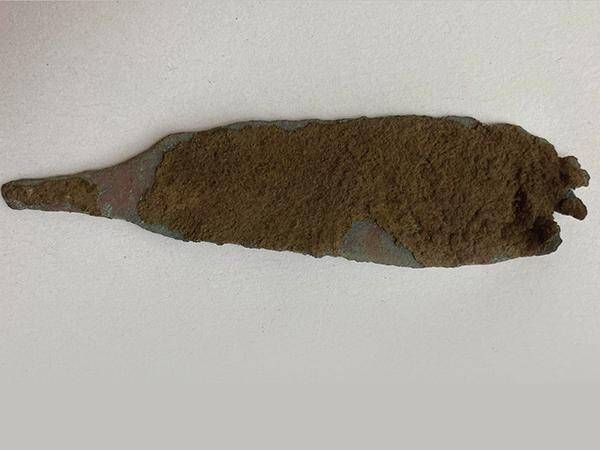A rare dagger dating back to the Copper Age more than 4,000 years ago was found in the Tina Jama cave in the Trieste Karst in Sgonico, together with abundant ceramic remains and stone artefacts thanks to the excavation campaign by researchers from the Ca’ University Foscari of Venice. A structure made of stone slabs and blocks was also discovered which closed the entrance to the cave in a period probably between 2,000 and 1,500 BC, whose function is still mysterious but perhaps connected to funerary purposes, as one might think. some fragments of human skulls partly associated with it. However, the structure could also have been created to protect the interior of the cave from the bora winds.
The exceptional discovery was presented today (Wednesday 23 October) in Trieste at Palazzo Economo, in the headquarters of the Superintendency of Archaeology, Fine Arts and Landscape for Friuli Venezia Giulia, in the presence of Monica Hrovatin, mayor of Sgonico, Andrea Pessina, regional secretary of the MiC for Friuli Venezia Giulia, Roberto Micheli, official of the Superintendence, Federico Bernardini, professor of Archaeological Research Methodology at the Department of Humanistic Studies of the Ca’ Foscari University of Venice, and Elena Leghissa, of the Institute of Archaeolgy, Research Center of the Slovenian Academy of Sciences and Arts.
The new investigations have made it possible to reconstruct the history of the north-eastern Adriatic regions over a long chronological period between approximately 9,000 and 4,000 years ago using modern excavation methods. “The excavation at the Tina Jama cave, conducted by an Italian-Slovenian team, aims to clarify various aspects of the recent prehistory of the north-eastern Adriatic regions, adopting a modern and rigorous approach. At the same time, it offers an important educational experience for students Italian and international”, said the director of the excavation Federico Bernardini. “Excavations at the Tina Jama cave have revealed layers from the Bronze and Final Copper Ages, dating back to the second half of the 3rd millennium BC, crucial for understanding the technological, cultural and social transformations of Europe in that period. The continuation of excavations will deepen the relationships between the different cultural facies of the 3rd millennium BC in the Caput Adriae area”, added Elena Leghissa. According to Bernaridini and Leghissa, “the discovery of a rare copper dagger, dating back to the second half of the 3rd millennium BC, is an exceptional event that raises questions about the use of the cave, given that such precious artefacts are generally found in burial contexts”.
The excavation campaign is conducted by Ca’ Foscari University, under excavation concession for the Ministry of Culture – Superintendency of Archaeology, Fine Arts and Landscape for Friuli Venezia Giulia, in collaboration with the Institute of Archaeolgy, Research Center of the Slovenian Academy of Sciences and Arts, the Abdus Salam International Center for Theoretical Physics and the University of Siena.
Not far from the top of Mount Lanaro/Volnik, in the Tina Jama cave, in the municipality of Sgonico – Zgonik, in the Trieste Karst, the ongoing Italian-Slovenian research is making it possible to reconstruct the history of the northern Adriatic regions with modern excavation methods -eastern in a long chronological span between approximately 9,000 and 4,000 years ago. In fact, the second excavation campaign is about to end, conducted under ministerial concession under the direction of Federico Bernardini of the Venice Center for Digital and Public Humanities and the Venice Archeology Study Center of the Ca’ Foscari University of Venice. The research was also carried out thanks to the collaboration with the owners of the land Marino Pernarcich and Paola Zivec, as well as the agricultural companies Marucelli Omar and Milič Zagrski, who with their enthusiastic support and fundamental logistical support made the research activity on the field.
The excavations, which mark a resumption of archaeological investigations in the Karst caves after several decades of inactivity, have made it possible to reach levels attributable to the Copper Age in which a rare copper dagger dating back to more than 4,000 years ago was found, as well to abundant ceramic remains and stone artefacts.
Before the creation of this cave, the collected ceramic materials and the presence of a hearth suggest that the cavity was frequented by groups whose material culture suggests close contacts with the Dalmatian area in the second half of the 3rd millennium BC (Cetina culture). The copper dagger comes from these levels; it has a length of just under 10 cm and a leaf shape with a tang. Similar finds have no specific comparisons in Italy, while the Tina Jama artefact can be compared with similar finds from a famous pile-dwelling site near Ljubljana in Slovenia, the Dežman/Deschmann pile-dwellings.
Materials brought to the surface by animals, including flint arrowheads, long pressure-produced blades of the same material, an obsidian artefact (volcanic glass imported from southern Italy or central Europe), polished stone axes, other lithic artefacts and ceramics and shell ornaments demonstrate that the cave has been frequented for millennia and bode well for future excavation campaigns.

Fatal error:
rinoplastiaultrasonica rinoplastia ultrasonica – Info – Battlecam
Certificate verification problem detected
fritzchildress | Users | joinDOTA.com
korastar9 | eTwinning Online Eğitimler
public.tableau.com/app/profile/sora.condo4740/vizzes
robertmilton – Usuarios – Observatorio Medioambiental La Plata
FitDay Discussion Boards – View Profile: esperanzadaly
Jawa138: Situs Terpercaya Untuk Memuaskan Hobi Bermain Slot Online – Surgawin
Livedraw HK: Tempat Menemukan Hasil Undian Lotere Langsung » Dailygram … The Business Network
– – Media/News
Certificate verification problem detected
Nava Grove Showflat _ 90918891.pdf
Togel Online Terpercaya? Coba Situs Toto!
Account Profile | CHIRP Radio
Xero | rinoplastia ultrasonica
Lepaskan Kegembiraan dengan Slot 1000 – Undeated Movie
Miracle Haisley | lindseywilsoncollege
Allegra Lace's Profile page
Alumni Feedback Survey –
billierichey billierichey, Pengarang GEOTIMES
Innovation Dashboard – Discussion Forum
Right Removals Waterlooville – Answers
Livedraw HK: Sumber Informasi Terkini Lotere Lan…
EFG – Escuela de Formación Gráfica
Bejelentkezés | otthoni munka, pénzkeresés
Permainan Slot Online Menguntungkan Dan Terpercaya Di Kombo88
EFG – Escuela de Formación Gráfica
editormeda
Profile → Ajustes – E-Global